A Loving Attitude and the “5As” are Making a Huge Difference in the Enneagram Prison Project
What I Witnessed, Working with Susan Olesek and the EPP
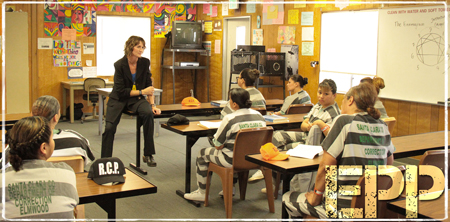 Susan Olesek, an enthusiastic reformer type who had just certified as an Enneagram teacher — through the school that I co-founded in 1988 with Helen Palmer —told me about her having been invited to teach an extended Enneagram class to inmates in a Texas prison. We all thought it was kind of a big deal and very courageous of her. Four years later, I watched Susan muster up the gumption to found a nonprofit that she and her founding board members named, “The Enneagram Prison Project (EPP).” She told me that she witnessed, time and time again, the incredible effect learning the Enneagram was having on the inmates she had been teaching, and she felt compelled. She felt she had to do something to bring this system to more than just those in Texas who had found themselves in a prison of their own making, and behind bars.
Susan Olesek, an enthusiastic reformer type who had just certified as an Enneagram teacher — through the school that I co-founded in 1988 with Helen Palmer —told me about her having been invited to teach an extended Enneagram class to inmates in a Texas prison. We all thought it was kind of a big deal and very courageous of her. Four years later, I watched Susan muster up the gumption to found a nonprofit that she and her founding board members named, “The Enneagram Prison Project (EPP).” She told me that she witnessed, time and time again, the incredible effect learning the Enneagram was having on the inmates she had been teaching, and she felt compelled. She felt she had to do something to bring this system to more than just those in Texas who had found themselves in a prison of their own making, and behind bars.
Susan was honest with her fears and doubts when she first started out, as not many had ever attempted to teach the Enneagram system on a consistent basis in penitentiaries or jails. Would she get it right? Did she know enough? Would the inmates have any interest in this at all? Could they learn this? Would it make sense to bring this to prison? And on and on and on, she fretted quietly.
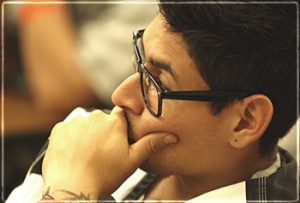 What Susan continued to share with me was her compassionate discovery of the soulful, so-eager-to-learn humans behind bars that she encountered. She would tell me of their almost willingness to devour the information and the teachings. She reported out that inmate after inmate came to understand and then became willing to share how the blind spots in their Enneagram personality structures had gotten them incarcerated. She saw them switch from blaming the system or blaming others to taking responsibility for themselves, for their choices, and for their reactivity.
What Susan continued to share with me was her compassionate discovery of the soulful, so-eager-to-learn humans behind bars that she encountered. She would tell me of their almost willingness to devour the information and the teachings. She reported out that inmate after inmate came to understand and then became willing to share how the blind spots in their Enneagram personality structures had gotten them incarcerated. She saw them switch from blaming the system or blaming others to taking responsibility for themselves, for their choices, and for their reactivity.
[box]I am compelled to make this point: People behind bars are people. They are just like you and me, humans just like the rest of us, with a personality structure and a boat-load of issues, challenges, and problems to cope with. More than most have dealt with abuses, adversity or childhoods you could not begin to imagine. They are not “a different species” or some untamable type of hopeless degenerate. These are sentient beings, many of which could possibly change their lives if given a bonafide chance at a second chance. The ones “who are ready enough” can do it, if given incisive-enough tools and the support they need.[/box]
In my earlier years, I consulted weekly for two-plus years at the O.H. Close Youth Correctional Facility in Stockton, California, working with jailed teenagers. I experienced how changing the staff’s attitude toward the teenaged inmates — from seeing them as human beings instead of some kind of damaged species — had a profound effect. I worked closely with the staff to foster this change in attitude and it resulted in the staff treating the teens with openness and respect, which in turn engendered positive developmental progress in the teens, that also included feelings of openness and respect.
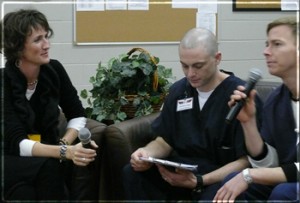 This is what I have witnessed is happening in the work of Enneagram Prison Project (EPP), fostered by Susan’s exemplary attitude toward those who have found themselves in the cycles of pain that leads to incarceration. Susan’s paved the way for her nonprofit organization, now-developing a core cadré of specialized teachers, to bring self-awareness training, through the Enneagram system, to inmates in both prisons and jails, and doing so with a particular recipe of warmth, respect, lots of love and care, and a deep regard for each inmate’s history and humanity.
This is what I have witnessed is happening in the work of Enneagram Prison Project (EPP), fostered by Susan’s exemplary attitude toward those who have found themselves in the cycles of pain that leads to incarceration. Susan’s paved the way for her nonprofit organization, now-developing a core cadré of specialized teachers, to bring self-awareness training, through the Enneagram system, to inmates in both prisons and jails, and doing so with a particular recipe of warmth, respect, lots of love and care, and a deep regard for each inmate’s history and humanity.
As a faculty member of the EPP Enneagram Teachers “Training for Prison” Program that was held this past April in Menlo Park, CA, I witnessed the trainees literally embrace those imprisoned, as the training included a few days actually working with the incarcerated. I even personally experienced the same paradigm shift — from fear and our society’s negative bias— to an utter acceptance, deep compassion, and regard.
This past year, I’ve had the great privilege to lead Enneagram Intensive programs for Enneagram Studies that included both Elam Chance and Victor Soto, two men who are now “EPP Ambassadors,” but who were former prisoners who had learned the Enneagram thanks to Susan Olesek and EPP, while still incarcerated. These are fine men now steeped in the study of themselves and the world around them, having gone from incarceration to wanting to make a difference in the lives of others.
These men are further exemplars of this simple fact: that working with those who are incarcerated is not to be considered working with “children of a lesser God.”
But how does such a powerful “transformation in attitude” come about?
In watching Susan and her team work with inmates, I could experience how centered, grounded, and receptive they had become in her presence and in the class.
I was taken by how much they were manifesting the 1st A of the Universal Growth Process, which is Awareness. This first A is the ability to become self-observant. The ability to ground oneself enough in one’s being, and self-witness. This is actually no small task and is the first great turn of any path of change or transformation we may hope to pursue.
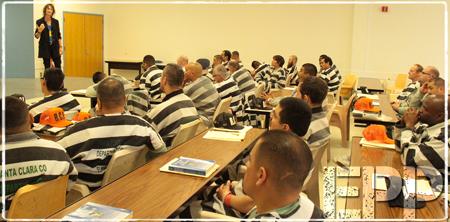 I watched these incarcerated men, who had never had any training in self-observation, suddenly begin to self-observe, thanks to the reverent teaching style of Susan Olesek, a style that has become the fundamental value system of EPP itself.
I watched these incarcerated men, who had never had any training in self-observation, suddenly begin to self-observe, thanks to the reverent teaching style of Susan Olesek, a style that has become the fundamental value system of EPP itself.
I also watched the second A of the Universal Growth Process take hold next: Acceptance. One of the most difficult and absolutely necessary parts of working with this population is to help them deal with the shame or guilt that arises as a result of the self-witnessing process, as a result of starting to become more “self” aware. Shame is so powerfully experienced in the body, almost as if “on the skin,” as shame holds within it humiliation and public scorn. It’s an experience that tells us that “we are bad, wrong, or utterly unworthy.” Guilt is a more internalized experience that tends to be directed at a behavior for which we look back on and feel bad about. Guilt’s intention is to steer us away constructively from doing something we feel bad about, again.
But here’s the key: the 2nd A of Acceptance, which means openhearted kindness toward our self and others as we become aware of ourselves and our reactions in any given moment, does not mean condoning, capitulating, or concurring with one’s own or others’ unwanted, difficult behaviors, or criminal behaviors. It means an “acceptance” of what’s witnessed within, a seeing “what is” as what is, with honesty and humility. This simple practice has its deeply critical, necessary place in our fundamental development, as the moment we can “accept” what we just became aware of – rather than block it or deny it or argue with it – we can start to work with it. This is where studying the Enneagram comes in. Navigating what we become “aware of” becomes incredibly easy with the Enneagram’s incisive map at our disposal.
In my opinion, it can become impossible for those men and women now serving as criminals to believe in themselves enough, to go through the pain of working through traumatic childhoods and the traumatic adult experiences associated with committing crimes, without first learning self-acceptance. Once capable of self-acceptance, self-understanding becomes possible, which then leads to the development of transformation within, which leads to different behaviors without. To do this? Those serving time need an incarceration environment that does not include being labeled “lesser beings,” which further exacerbates feelings of shame, hopelessness, and worthlessness, feelings that are known to induce cycles of criminal behavior, addiction, poverty, as well as even suicide.
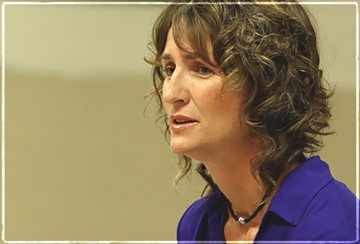 In observing Susan’s direct interactions with inmates, I noticed the 3rd A of Appreciation, A LOT, meaning a consistent application of the ability to express a genuine gratitude that nurtures both the appreciator and appreciate-ee. Appreciation for what was being shared and realized by each inmate was often present. These men and women had little experience with the giving or receiving of appreciation across their lives, many of whom suffered more commonly from chronic criticism and condemnation. Believe me, this 3rd A is of great importance when working with any individuals, let alone individuals such as inmates who are dealing with unfathomable amounts of stress, despair, and conflict.
In observing Susan’s direct interactions with inmates, I noticed the 3rd A of Appreciation, A LOT, meaning a consistent application of the ability to express a genuine gratitude that nurtures both the appreciator and appreciate-ee. Appreciation for what was being shared and realized by each inmate was often present. These men and women had little experience with the giving or receiving of appreciation across their lives, many of whom suffered more commonly from chronic criticism and condemnation. Believe me, this 3rd A is of great importance when working with any individuals, let alone individuals such as inmates who are dealing with unfathomable amounts of stress, despair, and conflict.
The 4th A, which stands for Action, means (1) observing both our positive (reactivity intended to make us feel better) and negative reactivity (aiming at defending and protecting, denying, resenting, or fighting), then (2) conducting an openhearted inquiry to determine its root cause, and (3) lastly, taking “thoughtful” action, action that is based on understanding what behavior —response — is actually needed and appropriate for the situation. I watched the 4th A readily utilized across the teaching efforts of EPP. The 4th A is the content part of effective interpersonal work, with the other four As constituting the process. Good work requires we pay attention to and include both process and content.
Lastly the 5th A is for Adherence, meaning, the practice of sticking with the work over time. The final step is absolutely necessary in order to bring forth lasting change. Much of our personality structure’s basic beliefs and associated reactivity occurred early in our lives. It is embedded in implicit memory, and therefore must be thoughtfully and patiently observed “when” it shows up on us and is actually occurring. This takes practice, as reactivity of this deeply rooted nature fires off rapidly, on auto-pilot, with little warning.
These 5 As are a fundamental part of Enneagram training and of EPP’s core teaching methods. Susan and EPP’s Guides stunningly effective way of working with these marginalized populations, using these tools and processes — designed to catalyze definitive change — is proof of their efficacy and power. I highly recommend the adoption of the 5 As for each and every one of us working with ourselves and others on the personal growth path, including and especially, when working with those imprisoned.
Incarceration is a costly endeavor, to both the lives placed behind bars to those who fund these institutions. Paradoxically, however, incarceration “can provide” a unique opportunity for personal reflection, the time and support to do so, and groups of others that may be enlisted to help each individual do the work. With programs now coming forth such as those offered by EPP, our incarcerated population may be given a very new kind of chance at reform. One that firstly involves a paradigm shift in how we label and reach out to support people behind bars. And, secondly, by bringing some of the best tools out there to these populations, something they never had access to before. Something called the Enneagram.
 To learn more about Susan Olesek and her devotion to Enneagram Prison Project and its vision, listen to Susan’s 2016 Tedx Talk, “Both Sides of the Bars,” presented at the Washington Square Tedx, New York, NY.
To learn more about Susan Olesek and her devotion to Enneagram Prison Project and its vision, listen to Susan’s 2016 Tedx Talk, “Both Sides of the Bars,” presented at the Washington Square Tedx, New York, NY.
To read more about the Universal Growth Process that I developed with Enneagram teacher and colleague, Terry Saracino, click here. >>
JOIN THE CONVERSATION.
I would love to hear from you, my blog readers, friends and colleagues.
Share your thoughts and feelings. Check in with yourself: What’s your deeply held view of someone incarcerated? How would you like to see them treated? Some feel better about their society knowing the incarcerated are doing time and being punished. What is your view of punishment versus reform? Have you thought of those incarcerated as a transformable population?
What does the work of EPP mean to the fundamental goal of of the Enneagram associations to bring the Enneagram further into the world? I would really enjoy hearing from you.
Appreciatively (the 3rd A!),
David
3 Archived Responses to “A New Paradigm: The Enneagram Prison Project”
Anonymous says:
June 24, 2015 at 7:48 pm
Hi David,
A little bit “off topic” here, but I am so glad that EPP is now working w/women in prison. I was beginning to wonder why “the prisoners” (up to this point) were particularly “male dominated,” and there seemed to be no woman’s voice from inside. So, hopefully, this will soon change. Much work to be done there.
Love, Kathy Hyde
David Daniels, MD says:
June 29, 2015 at 11:41 am
HI Kathy,
Yes, we are working with women in jail and it is very powerful because the distress over not having bonding, connection, and love in their lives is great, and it’s directly related to their suffering, addiction, and arrests. Good to hear from you. Love, David
Anonymous says:
June 29, 2015 at 10:54 pm
Kathy, You’ve noticed such an important piece of our work. Actually, I have been working with the women for as long as EPP has been at Elmwood, however, but we are just now being joined by our first female ambassadors on the outside. They will be adding a crucial and very different voice to this topic, as David clearly notes. Without exception, when I work with the women there is a huge curiosity to discover themselves and a tenderness in them that readily emerges for themselves and for one another. Mostly what they need is just a little safe space to reflect. Thank you for noticing what was missing! And thank you, David, for such a moving account of this work that you are so gently carrying forward.


